| HANG GLIDING ARTICLES, AUTHOR..George Ferris |
| THE BELOW ARTICLES: ...(1) Flyability, (2) 25th Annual Halloween Fly-In (3) Bushwhacker, (4) Newlyweds, (5) Valley Of The Brave, (6) Birds In Paradise , Link to Ole Olson's WILD BLUE YONDER book page,...+...., Photo Gallery |
| .................................................., FLYABILITY ,...................Author-George Ferris This article is about the most amazing person I have ever met. His name is Steve Varden. This article was published by Hang Gliding magazine in May of 2004 |
FLYABILITY
Founder of Flyability, Steve Varden, proves disabled persons can achieve dreams.
By George Ferris
January, Wallaby Ranch, Florida,
I was leaving the pole-barn making my way to the bathhouse late one evening when I noticed someone attempting to open the bathhouse door. It was dark and hard to make out details, but there was no mistaking that this individual was out of control. His arms and hands were gyrating back and forth over his head and he was swaying first one way then the other, his spindly legs barely supporting him.
As a watch with concern, he managed to open the door and entered the bathroom, letting the door closed behind him. It must have taken him a full minute to take those few steps from the outside of the door to the inside. How he managed to get himself to the door, and where he had come from before that, I did not know. The only thing nearby was a golf cart. Maybe someone had dropped him off!? But there was no one else in site.
I didn't wait around to solve this mystery........................ Continued Page 1, third paragraph
|
 |
| Flyability article page 1 |
|
|
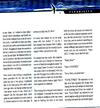 |
| Flyability page 2 |
|
|
 |
| Flyability page3 |
|
|
| .........,25th ANNUAL.. SEASCAPE, CAPE COD HALLOWEEN FLY-IN. Author George Ferris, This article was published by Hang Gliding magazine in October 1999 |
| IN MEMORY OF>> CHUCK NYHAN, OWNER OF THE SEASCAPE, JEFF NICOLAY OF MORNINGSIDE FLIGHT PARK WHO WAS THE FIRST PILOT TO FLY THE SEASCAPE, DORIS FROST BREDBERG AND BART CHAPMAN JR WHO WERE THERE IN 1928, WHO I MET PERSONALLY. AND SPECIAL THANKS TO GB CHARLES WHO INTRODUCED ME TO DORIS FROST BREDBERG FOR WITHOUT HER DIARY THIS ARTICLE WOULD NEVER HAVE THE IMPACK THAT IT IT HAS WHEN IT COMES TO THE HISTORY OF FLIGHT THAT TOOK PLACE ON CAPE COD. THEY SURPRISED ME WITH A EYE OPENING HISTORY OF HOW SOARING BEGAN ON CAPE COD. ALL OF OF THESE PEOPLE HAVE BECOME PART OF ME! Also , thank you to all that contributed to making this article possible: Chuck Nyhan, owner of the Seascape, Jeffery Morris, Curator, Pilgrims Monument and Provincetown Museum, Joan Morris, Curator of Wellfleet Historical Society, Dian Shumway, Curator of Truro Historical Society, Dave & Lori Sexton Owners of Cooks Camp, Doris Frost Bredburg for her diary and taking the time to talk to me, GB Charles that introduced me to Doris and made me aware of Doris's diary , The Connecticut pilots/club, Paul Voight, John and Mo Hamelin for sending photos. |
PREFACE: CLICK ON ANY PICTURE TO ENLARGE
This article is about the history, the beginning of glider soaring in the USA that started in 1928 in Truro on Cape Cod. How the people involved back then are linked together with the Pilgrims in the year 1620, the first Thanksgiving in the year 1621, the eventual German Luftwaffe in 1935, JC Penney of the JCPenney retail stores in 1928, the Seascape in North Truro, and Dave & Lori Sexton present owners of Cooks Camps in Wellfleet which is a stones throw from the hang & paraglider launch that exist in Wellfleet to this day.
This article started out as a simple article but after the years of research it turned into an extensive history lesson about the above.
|
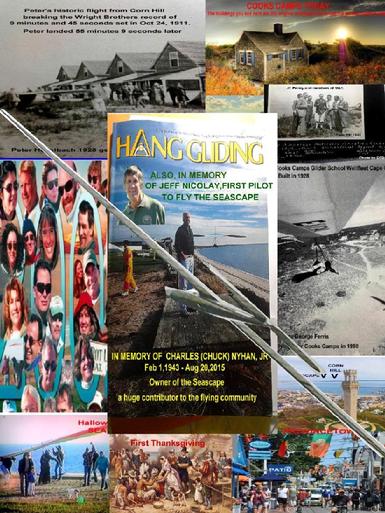 |
| George Ferris, Author, I wrote this article in 1999 and restored it on Nov 23rd of 2017. The Seascape closed in 2013.The link to this article was lost when the Seascape's web site closed along with the Seascape. |
|
|
 |
| The first Thanksgiving |
|
|
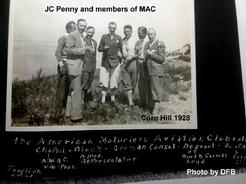 |
| MAC (American Motorless Aviation Club) |
|
|
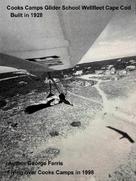 |
| Author George Ferris, Flying over Cooks Camps |
|
|
PAGE (1) OF (6) : THE BEGINNING
In 1928 a glider pilot, Peter Hesselbach, atop Corn Hill in North Truro Cape Cod readied himself in his glider. There before a large crowd he prepared to launch into the ocean breezes, excited about the fact that he could break the Wright brothers duration record of 9 minutes 45 seconds set in 1911.
PETER YELLED CLEAR AND THE GLIDER WAS LAUNCHED.................
Little did Peter or anyone else realize that his historic attempt that day at Corn Hill was taking place from a ridge that would be the future hang gliding flying site for the annual Halloween Fly-In which began in 1974 at the Seascape. Also many were unaware that this hill , because of the pilgrims, played a significant role in American history in the year 1620, it was the birth place of Thanksgiving.
In 1620 the Mayflower left England filled with pilgrims bound for the Virginia's. The ship was blown off course by a vigorous storm and found shelter in the harbor of a peninsula shaped like a fish hook. This peninsula stretched out into the ocean 40 miles from mainland Massachusetts and was eventually named Cape Cod. Finally, anchored in the safety of the harbor, the captain announced the ship was damaged and would not be unable to continue to the Virginia's.
The pilgrims moved onto the shore and ventured out into this new land in search for food and water. Plenty of fresh water was found, but as winter approached their rations diminished. In late November during this search for food they climbed to the top of the hill on the shore in North Truro. This much is fact. What followed depends on who is telling the story. Most accounts tell of the pilgrims finding a large corn field on a hill top that they harvested to supply themselves through the winter months. But further research revealed another story. The true story! The pilgrims discovered sand mounds on top of the hill. The mounds were on top of graves, it was a Indian burial ground. The Indians believe that giving a portion of their harvest to their ancestors would guarantee a plentiful harvest the following year. Buried in the sand on top of each grave were large pots filled with corn. The pilgrims uncovered these large pots, finding the corn. Since that day the Pilgrims called this site Corn Hill.
It was recorded at a later date that the Pilgrims admitted taking the corn from , unknown to them, the grave site. They stated that because of their food shortage they were desperately in need of seed for the following year and that they vowed to make restitution. In part, that restitution came in the autumn of 1621. The corn they had taken from the graves produced a large flourishing crop that summer. The Pilgrims invited the Indians ( Wampanoag /?w??mp?n???/, also called Massasoit), sitting side by side, they celebrated a week- long feast. We still celebrate this feast in November, we call it -Thanksgiving. There is a plaque on Corn Hill commemorating the historical event of the pilgrims finding the corn.
|
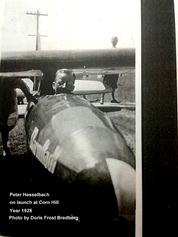 |
| Peter Hesselbach , German glider pilot on top of Corn Hill, 1928 |
|
|
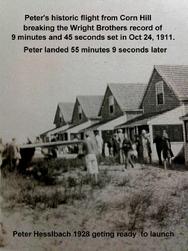 |
| Peter Hesselbach ready to launch from Corn Hill in 1928. Photo By : Doris Frost Bredberg, |
|
|
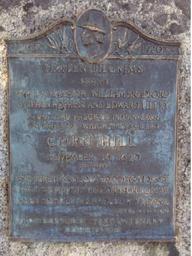 |
| Plaque commemorating the finding of the corn buried on Corn Hill in 1620 |
|
|
PAGE (2)
HALLOWEEN FLY-IN, HOW IT BEGAN & INTERVIEW WITH CHUCK NYHAN OWNER OF THE SEASCAPE.
For 25 years, Chuck Nyhan, owner of the Seascape Motel, commonly referred to as Chuck's, has been hosting the Halloween fly-in. The fly-in was given this name because it was held the last week of October into the Halloween weekend. The hang gliding community owes a debt of gratitude to Chuck. Chuck welcomes all hang glider pilots with open arms at his motel, and has made flying on Cape Cod what it is today.
According to Chuck, Jeff Nicolai, who now runs Morningside Flight Park in New Hampshire, was the first pilot to approach him about flying at the Seascape. The flying here all began with Jeff.
The following is a interview I conducted with Chuck for this article.
(George): Chuck, when were you first contacted about flying at the Seascape?
(Chuck): In October 1974 Jeff nickel I called, asked me if he could come to the Seascape and fly his hang glider from the bluff from the motel Bluffs. (George): Where you apprehensive, did you even know what hang glider was? (Chuck): Actually I was very excited about it, having watched hang gliding slide from Piko peak in Vermont. (George): After initial trip to the Seascape, what group of Pilots were responsible for making the annual event it is today? (Chuck): The Connecticut Pilots, many of the pilots have been coming since the middle of 1970s. John and Moe Hamlin along with Wayne and Holly Ripley and Tom and Barbara Johnson have been coming to the Halloween fly since its Inception. The Connecticut Club is taking on responsibilities of acquiring insurance and posting rules for flying at the Seascape. (George): Have you ever been up tandem? (Chuck): No! I'm afraid of heights. (George): What was and is the attitude of Truro & Provincetown towards hang gliding? (Chuck): The attitude of the people in these towns has always been very positive. (George): Is the week of the Halloween flying the last week you are open for the season? (Chuck): Yes (George): Would you still be open this week if it weren't for the Halloween flying? (Chuck): The weather has changed in the last 20 years it's much warmer in the fall on the cape than it used to be. I would still be open because of the warmer weather but, of course, we wouldn't have the number of people that the fly-in generates. (George): Are you planning on retiring soon? (Chuck): No! NO!! NO!!! (George): So pilots can look forward to many more years of Halloween fly-ins to come?
(Chuck): Yes, as long as I'm here.
(George): Thank you Chuck for taking the time for this interview, and thank you from all of us who have experienced the beauty of flying at the Seascape.
PAGE (3)
ABOUT THE SEASCAPE
The Seascape couldn't be located in a better place on Cape Cod for hang gliding. It is on the bay side of the cape in North Truro which borders Provincetown, which is located on the very end of the Cape. The Seascape sits on the north end of a south-west facing dune that runs 4 miles south and ends at Corn Hill. North of the Seascape the dunes come to a stop and the land is just above sea level dotted with cottages and motels all the way to Provincetown. Those of you who have been to Fort Funston or Tori and can imagine a single-story Motel running parallel 70 and 75 feet from the edge of the cliff can picture what it is like. The Seascape launch is 75 feet from the door of your motel room. While sitting in your room you can watch pilots flying and launching. After an hour or two of flying you can land for a sandwich and return to the air. For families it's a short walk down to the beach or a short drive into Provincetown. North of the Seascape resembles a fish hook and the remaining 15 miles of land offers a spectacular view of Provincetown Harbor and the end of the Cape. The sunsets are some of the most beautiful you will ever see. In the evening the lights from Provincetown glitter over the water lighting up the Provincetown harbor. During a full moon the beach lights up like a beacon since the moon acts like a spot light beaming across the water. During the day the colors of the land and water are a sight to behold, especially from the air.
There are basically two good wind directions for flying at the Cape, east and southwest. The bayside is southwest. The dunes at the Seascape started a height of 75 ft varying up to 100 ft and run south 4 miles to Corn Hill. The Oceanside dunes, Wellfleet, vary in size from 10 ft to 200 ft and run for many miles. Some pilots arrive at the Seascape, set up their gliders, and need not brake them down. For some years it blows southwest all week long. There is plenty of beach to land on especially at low tide and some pilots carry there gliders back up the stairway fully assembled ready to fly again.
Cape Cod is a magical place of beauty and history. Provincetown at its tip became a Township in 1727. The little village that was once sustained buy fishing has become one of the many tourist towns, and has many shops, restaurants and bars along it's quaint, narrow streets. During the summer months its streets and shops are filled with people. Provincetown is the home for many artists, since the town and its surroundings are art themselves. Nestled at the tip of the cape, on a strip of land at its end not even a city block wide, it is a sight to behold when flying the bluffs at the Seascape. There is so much history associated with Cape Cod that I doubt anyone can put it all down on paper in a lifetime.
|
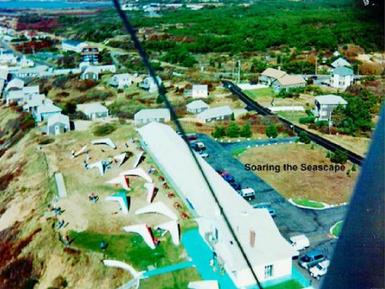 |
| Seascape as pilots see it from their gliders |
|
|
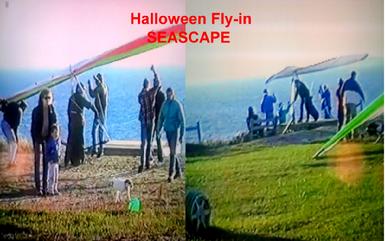 |
| The Seascape launch |
|
|
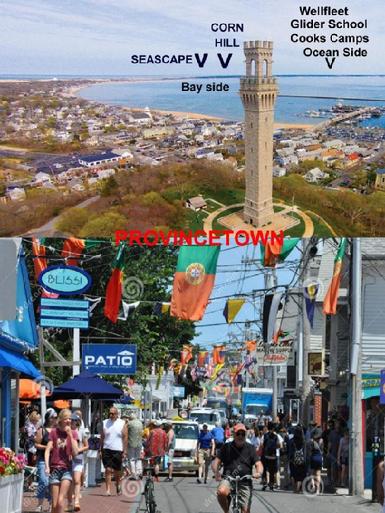 |
| Provincetown, Pilgrims Tower & location of Seascape,Corn Hill, Wellfleet Glider School/Cooks Camps |
|
|
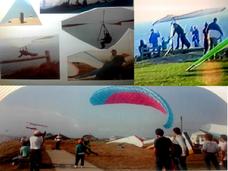 |
| Families & Pilots at the Seascape |
|
|
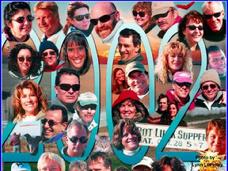 |
| Pilots & families that frequent the Seascape |
|
|
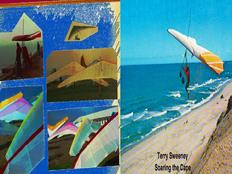 |
| Pilots at the Seascape and Terry Sweeney soaring the Glider School Dunes |
|
|
PAGE (4)
THE HISTORY OF SOARING IN THE US THAT STARTED ON CAPE COD
The sport of soaring is part of Cape Cods history, but sadly, this is unknown to most Cape Cod residents and pilots except for a few historians. When the Wright Brothers attached an engine to their glider, further research into gliders came to a standstill. Following World War 1, the Versailles treaty prohibited the Germans from training more than a small number of powered aircraft Pilots. The treaty, like many contracts had its loopholes and the Germans used one of those loopholes to begin training pilots in unpowered aircraft. Gliding was reborn, but this time it's evolution was backed with monies and resources from the German government. Picking up where the Wright brothers left off, but with superior materials and new technology developed building motorized aircraft during World War 1, gliding advanced rapidly in Germany.
In 1927 JC Penney Junior of the now famous Penny retail chain was visiting Germany and was amazed that the advancements the Germans had made with powerless aircraft. When he learned that the gliders could be launched from a mountain or hills and stay aloft for hours and travel significant distances he was committed to bringing this knowledge back to the US. He returned to New York City and formed the American Motor less Aviation Corporation ( MAC) for short. MAC provided funds for a handful of German pilots and instructions to come to America and teach gliding.
JC Penney spent his summers at Cape Cod with his family and his familiarity with the dunes and consistent winds as well as the relatively close proximity of the Cape to New York City prompted MAC to establish two sites for gliding. The first was a top Corn Hill the south end of the same dunes that the Seascape is located on which faces into south westerly winds and that would be the main site for soaring and breaking records. The fact that this was the same hill where the pilgrims had found the corn which led to the birth of Thanksgiving was strictly a coincidence. The other site was home to a training school set in Wellfleet at a place now call Cooks Camp. This is the same area that everybody visits today, in Wellfleet, to go flying. Both of these areas had been flown by hang glider Pilots for 18 years with no knowledge of MAC, German glider pilots trying to break the Wright brothers record in 1928 or a school dedicated to gliding in Wellfleet in 1928. I first became aware of this in 1993 while searching for a new launch site near the existing Wellfleet take off on the east side. One beautiful no wind day I decided to go to Wellfleet, the ocean side, and search of other takeoffs. The ocean side is National Seashore property and this made finding new takeoffs difficult. The National Seashore Community has banned all further development and has prohibited walking on almost all the dunes except for the existing launches. However there are many houses and Cottages that were built before the area was deemed National Seashore. I, along with my flying partner John Sillero, have spent countless hours approaching homeowners to ask if we could use their front yards to launch. Years have gone by without any luck because the people who own summer homes are very seldom there and they are naturally concerned about liability. So on that hot summer day I ventured up a road marked private that I had passed by for 20 years just a short distance from the Wellfleet take off. The road rounded up through scrub pines and came out in a large clearing surrounded by cabins sitting at the top a hundred foot Dune. I had noticed these cabins while flying two days earlier. I introduced myself to Dave Sexton and his wife Lori who turned out to be the owners. I explained that I was a hang glider pilot that was flying over this stretch of dune 2 days earlier. The conversation that followed changed my perception of gliding at Cape Cod and inspired me to research this topic which turned out to be more interesting than I ever imagined. Our conversation went as follows.
PAGE (5)
DISCOVERY OF THE
WELLFLEET GLIDER SCHOOL
INTERVIEW WITH DAVE SEXTON, OWNER OF COOKS CAMP HOME OF THE GLIDER SCHOOL IN 1928
(Dave): George do you know that in 1928 this was the site of a glider school? (George): . A glider school !!!??? WHAT!! (Dave): YES!! ( George): A glider school, I don't understand. (Dave): Well ,as he motioned this way and started walking toward the middle of the Cottages, all these buildings that you see here were built in 1927 to house the German glider Pilots, instructors, gliders and their horses. This was the photo lab and over here, as we walked, these were the stables where they kept the horses they used to use to retrieve the gliders back up the sand dunes after flying down. (George): What are you kidding!!??, German glider Pilots were flying here in 1928. (Dave): yes, this was a glider School. In 1927 my wife's grandmother who owned the land leased it to MAC ( Motorless Aviation Club). MAC hired contractors to construct these buildings for the glider school. Walking as we talked he led me into the officers bath house which is almost untouched of this day. In the bath house there are two main rooms one of which has toilets and sinks. Another room a shower about 12 by 15 feet is laid with ceramic tile except for the cedar vaulted ceiling and has 10 or so shower heads. (George): Dave how long did the school exist? (Dave): The school was started 1928 and closed in 1929. (George): Why such a short time? (Dave): Well my wife tells me that her grandmother said that the local people did not like the German pilots being here. The locals were convinced that they were Luftwaffe ( German Air Force pilots) training for the next World War. According to the grandmother the towns people pressure the Germans into leaving and return to Germany. (NOTE::Further research indicates that the reason they left was that MAC ran out of funding when the stock market crash in 1929.)
|
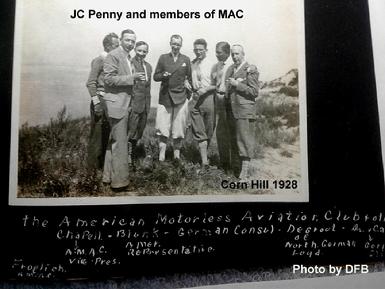 |
| JC Penney and MAC members |
|
|
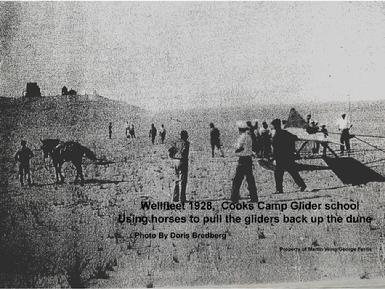 |
| Wellfleet, Cooks Camp Glider School |
|
|
 |
| Cooks Camps Glider School, Wellfleet, as it looks today |
|
|
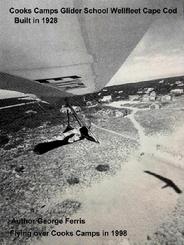 |
| George Ferris,Author, Flying over Cooks Camps Glider School in 1998 |
|
|
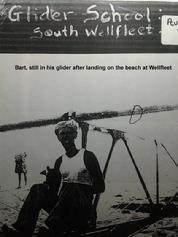 |
| Bart Chapin JR landing on the beach, Wellfleet Glider School/Cooks Camps |
|
|
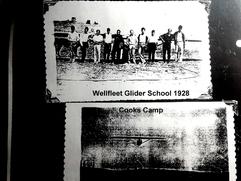 |
| German Pilots and Students , Wellfleet Glider School/Cooks Camps |
|
|
In 1928 a glider pilot, Peter Hesselbach, atop Corn Hill in North Truro Cape Cod readied himself in his glider. There before a large crowd he prepared to launch into the ocean breezes, excited about the fact that he could break the Wright brothers duration record of 9 minutes 45 seconds set in 1911.
PAGE (6) THE ENDING
PETER YELLED CLEAR AND THE GLIDER WAS LAUNCHED....................
Among the people watching that day was a young woman, Doris Frost , who had met Peter weeks earlier and befriended him. Doris kept a diary about the flights that took place that year and the people who were in attendance. Today Doris Frost Bredberg at age 89 tells me Peter's story while I page through her Diary. " Peter was very nervous that day even though he had soared many times for over an hour in Germany. He said that the first few minutes were the most nerve-wracking he had experience since his first solo flight. Peter told me that there was a possibility that the lift could disappear because of a change in the wind. He knew if this happened before he beat the Wright Brothers record in the presence of this large crowd, many of them socialites from New York and Boston, he would be a failure. That caused him to burst into a sweat. He told me that all his nervousness disappeared at the 10-minute mark when the crowd let out of Roar. Champagne bottles were opened in celebration and when Peter landed 55 minutes 9 seconds later he joined the celebration. I remember Mr. Penney and his friends were jubilant and declared Peter a hero. The very next day he broke the record again, soaring for 4 hours and 55 minutes.
Like the pilgrims harvest and Peter's record-breaking Flight 71 years ago each Halloween fly in ends with a large party. Most everyone dresses in costume many of the pilots and their wives spend the summer months making their own. The party starts off at the Seascape then ventures into the restaurants and bars in Provincetown lasting well into the night and capping off another fly-in. 1999 is the 25th consecutive year that the Halloween fly-in has been held at the Seascape on Cape Cod thanks to Chuck Nyhan.
|
|
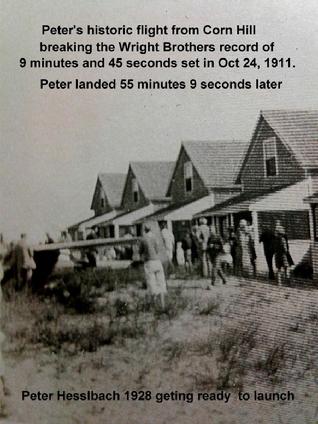 |
| Peter Hesselbach ready to launch from Corn Hill in 1928. Photo By : Doris Frost Bredberg, |
|
|
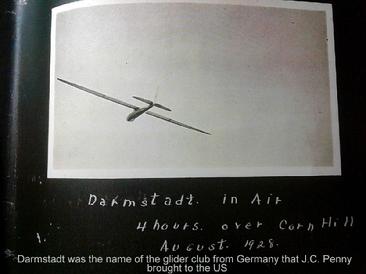 |
| Peter Hesselbach in the air over Corn Hill ,1928 |
|
|
| .....................................BUSHWHACKER SHORT STORY............................... |
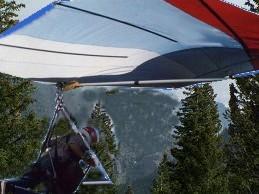 |
| Green Mt Launch |
|
True Story...... By Rich Laport & George Ferris
Rich Laport Wrote:
Hey George, remember that day we dragged our shit up on top of Green Mtn. in Claremont NH, but it was strong cross out of the north? You launched first and got your ass kicked, and had to land in this guys back yard by his pool. Wild ride. I walked down. My wife Alesia & I went by there on our ATV this past Monday. Great memories!! Well maybe not for you, but for me it was!!
I sure do remember. Of-course, they're all great memories Rich!!! I always think about how lucky we were to experience those early days ( early 70s) of hang driving and being some of the lucky ones to survive. That air was some of the most turbulent air I've ever been in. I remember it all.
The launch was a rock cliff, a nasty launch with big pines that you had to make it over and through. I remember just going for it then getting my ass kicked as I plummeted toward the ground.
Looking down I saw nowhere to land and knew I was going in....yes into a neighborhood with nothing but small back yards. The houses close together and all the back yards were fenced in. I remember picking the back yard with a inground pool. My decision was to crash into the pool figuring I would save myself and do less damage to my glider (Kestrel). As I dove for the pool from 50ft or so I saw a lady sunning herself. When she spotted me she stood up. I didn't have time to ask her permission to land in her pool so I focused back at the pool.To my disbelief and horror there was a little girl in the pool. I could hear here screaming as I approached at high speed and dove for the top of the fence at the end of the pool. I cleared the fence by a matter of feet and flared rising up then landing unbelievably on my feet between the fence and the diving board. As I did I heard the screaming come to an end. I looked over where the mom had been standing and didn't expect to see here there. I thought she would have made a mad dash into the house to call the police. To my surprise she was jumping up and down saying " CAN YOU DO THAT AGAIN" CAN YOU DO THAT AGAIN"!!!!
I couldn't believe what I was hearing but I was so relieved that I didn't hurt anyone or do any damage to anything including my glider I collapsed on the ground. At this time she did go into the house and returned with a lemonade.
I packed up and as I was leaving I remember her asking me if I was going to fly again. I remember looking at her with a grin, thinking to my self, " lady.... you have no idea how close I came to killing myself and maybe your daughter".
I answered her.... NOT TODAY!
Well Rich did you introduce yourself and tell her it was your crazy buddy that almost landed in her pool back in the 1970's. Knowing you probably asked permission to do it again.
That was my second best landing ever.
Yup, you were like a leaf blowing in the wind. It's a good thing that we can look back on that crazy shit and laugh cuz we survived it. I didn't stop to see if anyone was home, and no, I crossed that site off my list shortly after your feet left the rock!! Long live the Bushwhackers!!!!
|
| ............................,FLYING FOR THE NEWLYWEDS,............................. |
 |
| FLYING NORTH AT TORREY PINES, CA |
|
True Story.... By George Ferris
Patti , you surely remember this day!?
Ole, Talking about Torrey.... ask your buddy there if he remembers some guy that took off in a cross from the north. He flew south to the church at the request of some newly weds that call Torrey.
As he was getting ready to launch the Moyes boys ask him to fly there new glider, they wanted to know what he though of it. So he took off in there new glider flew down to the church made a couple of low passes so they could get their pictures and headed back.
By this time everyone had landed because the conditions made it almost impossible to stay up. It had crossed up even more and it was slow going and staying above the cliff was quite a challenge. He used the concave areas in the cliff facing north to gain 50 to 100 ft before darting to the next concave area. At the last concave area just south of the Torrey club house ( shop?) he fought to gain enough altitude to make it over the shop and land.
Unknown to him, instead of breaking down most everyone tied up there gliders to the rope anchors. I can't remember how high he was when he went for it but he wasn't high enough to see the part of the landing area just beyond (north) of the shop building. As he came in over the shop a look of disbelief come over his face. There in front of him was a sea of gliders and the only place to land with the altitude that he had was a vacant spot ( a missing glider) in the middle of all the other gliders. There was no time to think. He pointed his toes and focused on the spot. Came in hot pushed with his foot off the top of the glider king-post that was tied up rear of the vacant spot and flared up into the head wind and came straight down landing on his feet with his eyes closed.
When he opened his eyes again he was astonished by his luck. He was wing tips to wing tips, heel to nose and nose to keel. Other than pushing off the king post of the glider now parked directly behind him nothing had been touched.
The first thing he heard was the Moyes boys cheering "that's are glider", "that's are glider". Another person came running through the gliders. It turned out to be Patti Cameron. She looked him straight in the eye and said " that was my bran new gliders king post that you stepped on, I thought you were going to destroy my new glider that I just got, for sure".
A crowd of people filtered through the maze of gliders to come over to see who this crazy person was that just pulled off this landing. He sat under the glider not moving. I think he was in shock. He couldn't respond and didn't need to. The proud Moyes boys were still responding for him, promoting the landing capability of their new glider. I don't remember how long he sat there. The last thing I remember is the guy from the shop talking to him after everyone else left his side. All he said was " PLEASE!!! Don't do that again!"
What did I say!!!... nothing, I was still in shock.
|
| ...VALLEY OF THE BRAVE, JULY 1997 HANG GLIDING MAGAZINE |
Valley Of The Brave P-1
By George Ferris
Working my way up the side of the volcano I was anticipating the great pictures I could take if I made it to the center of the crater at 16,000 feet. I was told that in the bottom of the crater was a turquoise Lake.
Gini and I had just finished three weeks of towing on the frozen lakes of northern New York, our home, and we were excited about going south to a warmer climate.
We arrived in Mexico City on 19th of February and met up with Mark Greeley. That is where our adventure began. With map in hand, what seem to be a simple route out of the city turned into a two hour ordeal. Like mice in a maze we eventually learned where not to go and found our way out onto 15 West which took us to Valle de Bravo.( Valley Of The Brave) The brave part starts with you choose to rent a car in Mexio City and try to find your way out of this a-maz-ing city. Not counting our tour time we arrived there three hours later, just in time for dinner and a much needed Cuervo.
The next morning we were on her way to El Penon which we were told was the most consistent thermal site in Mexico. There were six people in our party: Mark Greeley from New Jersey, Hoss Anderson from Nevada, Linda Hodgson and Jim Afinowich from Arizona, Gini and myself. Accompanying us from Safari's guide tours were John Olson and Eric Lamberson, who lived in Valle, and our driver was Martine.
On the way over, smiling Ole John Olson our guide, interpreter and storyteller told us about all the landing areas. The landing areas are spread out 3 to 5 miles apart making for easy bailouts on one's way to goal about 19 miles back to Valle de Bravo. They all have unique names like La Mesa, Tanque de Gas and Rancho Viejo, to name a few.
Take off is at 7200 feet MSL 1500 feet AGL. The landing area below, called the piano, was described to us as a lion's mouth that would devour anyone attempting to land there. The dust devils, numerous barbed wire fences and power lines took no prisoners. The piano is famous for its downtube and occasional leading edge carnage. The idea at this site is to take off, high in leave.
Gini, however, not having a lot of cross-country experience, chose the land at the piano successfully several times after out climbing us in her 140 falcon she liked to land at the piano which she considered to have the best ground crew.
There is a wonderful phenomenon in Mexico. Almost everywhere you land children come out of nowhere to break down and carrier your glider to nearby road in hopes of earning a few pesos. The children are extremely friendly and happy. They have very little, but what they do have they appreciate. In addition, almost everywhere you land there seems to be a taco stand ,nearby. Its great, after the kids break down your glider you find the nearest taco stand quench your thirst and hunger or waiting for the retrieval van. By the way....... make sure you pay and say by to the kids before leaving, with your glider, to go to the taco stand. If you don't you will find more kids at the taco stand then you have pesos.... many many more.
CONTINUED BELOW:
|
|
|
|
|
|
P-2
Arriving at El Penon we wasted no time setting up since there were pilots high over takeoff. Eric is many gliders to choose from high-performance, intermediate and beginner wings- although I wouldn't recommend that a beginner pilots fly El Penon. The air on most days was a handful, and would certainly leave a beginner in the lion's mouth with no thoughts of flying there again.
On our first day conditions were anything but ideal, and most of us landed at las Penyitas, the first landing area behind takeoff. However, as the week progressed both the conditions and the pilots improved. Everyone made to cloud base many times and to San Gaspar- goal at least once.
Flying over Valle de Bravo to San Gaspar offers a picturesque site, as beautiful as you will ever experience. There are two primary landing areas on the lake. San Gaspar, at the north end, is fairly large LZ on the edge of the water at a marina. If you land there make sure you have your bathing suit. The water is great and it makes the retrieval time seem short. (Note make sure when coming in for a landing that you differentiate between the lily pads and land. Many pilots mistake the heavy lily cover for part of the landing area and end up in the water. )
The other landing area is called club Santa Maria, nickname the Postage Stamp, and it is. This is the primary LZ for La Torre, the favorite site of the locals. Takeoff is about 1200 feet AGL over the lake. The takeoff is directly over the town facing the lake, and has a beautiful cement takeoff. The wind comes directly off the lake and straight into the mountain. This site is soarable every day between 12 noon and 5 PM and produces one of the most scenic flights I've ever experience. The colors of the town, whites and reds, contrast with the green forest and blue shimmering Lake create such an inspiring image that you forget about the postage stamp landing.
This landing area is a short walk from town and pilots and tourists alike seek daily entertainment there. They all have their cameras ready as pilots com in to land. The LZ runs parallel to the shore and is shaped like a triangle. The tip of the triangle has water on both sides and is just wide enough to sit on. One-sided triangle of course is bordered by water and the other side has several 60 foot trees. The end of the triangle is twice your wingspan and to keep you from plowing into the boats and buildings there is a 12 foot fence at its end. The fences is bent over slightly from you know why. The triangle length is about 250 feet. It's a challenge, to say the least, but well worth it and great fun. About 85% of the pilots, paragliders and hang gliders end up in the water. Beginners fly with some type of flotation.
One evening at dinner Eric mentioned Nevado de Toluca, the volcano. Gini Marco and I had seen its snow-covered peak towering at 16,000 feet MSL on the way from Mexico City. Eric explained that it is not frequently flown because of its inclement weather and the difficult retrieval if you land out, but we decided it was a must. Eric said that he knew a pilot in Toluca who could tell us what day the weather would be favorable.
Valle de Bravo is a beautiful little town nestled in the mountains at 6000 feet MSL and a large pine forests on the edge of Lake of Avandaro. The city's whitewash stucco houses with red tile roofs complete the many colors of the town. Flowers are abundant everywhere. The town is built on a hillside overlooking the lake, a short walk down the cobblestone streets to the water edge.
There is a small park in the center of town, Plaza Independencia, which has brilliant flowers, trees and many park benches. In the morning the Plaza trees are filled with singing birds. Most evenings there is song and dance, for the plasma is a gathering place for all activities. For a few pesos you can dine at one of the many restaurants, listen to the singing and watch people's visiting the many unique shops. Dining at the Plaza with would your senorita, stars glistening, music playing is quite romantic.
In the morning there are fruit markets everywhere. Stores are abundant and all sell bottled water. There is a bank right by the plasm that opens every day at 9 AM were you can get seven pesos each American dollar. The accommodations provided to us by Eric were only a block away from the plasm. They were small but clean and comfortable. It costs only 100 pesos per night about $15 American. The only ....... CONTINUED P_3
|
|
|
|
|
|
| .............................BIRDS IN PARADISE |
| THIS ARTICLE IS DEDICATED IN MEMORY OF GERRY CHARLIBOIS. MAY GERRY SOAR AS HIGH IN HIS NEXT ADVENTURE AS HE DID IN THIS ONE! ...........................We'll all miss you Gerry!! .......................... 2014 |
BIRDS IN PARADISE, BY George Ferris
AT 6,000 feet I peered down into the 3 million year old Waialeale Valley hoping to spot the secret burial grounds of the ancient Menehune. The Menehune buried there riches in a cave behind one of the hundreds of 1000 FT water falls in this formidable valley. This particular day most of the waterfalls were dormant, for the past few weeks had been relatively dry.
Flying deeper into the valley with its 2,000 FT fluted cliffs, I worked the lift to maintain the altitude I would need to return to a safe landing area. At the end of the valley is Mt. Waialeale. This area is one of the wettest spot on earth receives some 600 inches of rain annually. To the west adjacent to the valley, is the Alakai Swamp, poised on top of the plateau at about 3000 feet, making it one of the highest swamp on earth. After a strong rain the swamp over flows and feeds the hundreds of 1,000 foot water falls that cascade down into the 2,000 foot Waialeale Valley.
About three miles back into the Waialeale Valley south of the north bowl, thinking I must be dreaming, totally aloof of the world, the wind direction changed and the bottom dropped out. I was about 4.5 miles from the beach designated landing area. I was sinking at 400-500 FPM and started racing north, out of the valley. About a mile from the chimney ( a fluted cliff on both sides running east- west) I wasn't confident I would arrive with enough altitude to fly over it. I needed to clear the chimney cliff in order to make it to the beach landing area. If I didn't arrive with enough altitude, to fly over the chimney, there were only two other options for landing. One was to land on top of the plateau in the Alakai Swamp which I was told was a three day walk out. The other was to land in the river bed below. I wanted nothing to do with that because more than likely I would never be found. I became as aerodynamic as I could .. hands together, face lying on my hands, arms tucked in as close to my body as I could get them, I sped north.
About 1/2 mile from the chimney and sinking at 500 FPM I prepared myself mentally for the three day walk out and initiated a turn to bale out onto the Alakai Plateau into the swamp.................
CONTINUED: Below
|
|
|
|
|
|
It had been two years of travel in hopes of flying exotic places with no success. Our first adventure was Costa Rica. Gini and I arrived having two contacts, one whom we never could reach and the other who left a few days before we arrived. The following year we toured South America first arriving in central Chili which looks much like southern California. There were mountains facing in every direction with four wheel drive roads to the top. We arrived at Eric's house to find he was in-
Venezuela. There were no other pilots to be found even at the 500 foot sand dunes on the pacific coast. Our next stop was Buenos Aries in Argentina. Buenos Aries is as flat as Kansas and there were no glider pilots to be found there either. Reaching Rio de Janeiro we called Mickey Splane to find he had left to pick up a schooner in California but his wife gave us a couple of contacts. Arriving at the landing area I was able to strike a deal with a local pilot Celso Saguaro to fly his glider, but to no avail. An unusual low pressure system developed and it proceeded to rain the remainder of our stay.
In January of this year ( I think 1997 ) Gini and I got the opportunity to go to Hawaii. After leaving Oahu with no success of flying we arrived on Kauai determined to fly even if it was a sled ride. Kauai is the most northern and least developed of the major islands. Most of its interior is mountain forest reserve. The Alakai Swamp is poised, about 1,000 feet below Mt Waialeale. There" clouds and mist that rarely lift support a unique ecosystem where trees only grow knee high. Kauai's main attraction is its stunning natural beauty. There are hiking tails into some incredible places.
Upon arriving, I called Gerry Charlibois of Birds In Paradise. I thought with our luck he would not answer. He did. I had contacted Gerry form the states, via Paul Voight and he assured me he had gliders and that I would fly. After three days of L&V and conditions that Gerry said were anything but desirable I was beginning to believe that our destiny was to visit these places of wonder but not to fly.
I suggested to Gini that we take a helicopter ride which we had never done before. We flew over the central part of the island to the Waimea Canyon. This canyon was called the grand canyon of the pacific by Mark Twain. The northwest part of the island was an untouched wilderness of beauty like nothing we had seen anywhere. It's valleys, mountains, and canyons, so primitive and untouched it must have looked the same when the Marquesan culture ruled the island back in 500 AD. Looking at its inaccessible beauty it was easy to understand why so many movies, King Kong" Platoon, Jurassic Park and Raiders of the Lost Ark, just to name a few were filmed here. I was pumped and called Gerry to tell him I just had to fly.
We arrived at Gerry's the next day to find him busy and not into flying. I explained to him that we had only one more day before leaving. Gerry assured me that we would go even if the trades didn't return. Our luck changed that night. Before we arrived back in Princville, where Gini and I were staying, the trades returned.
Gerry called early the next morning to say lets go flying. Arriving at Gerry's' in the town of Kappa the plan was to airflow me to the Waialeale ridge about l5 miles from our starting point. While I was soaring he would return to get Gini and they would fly back in the trike to take photos. Gerry explained to me that this would be an all day venture but would be a flight I would not forget. I was excited and nervous at the same time. I'm quite glider lingual having had the opportunity to fly every glider but one on the American market, of course that's the one he chose for me to fly, a Wills Wing Ram Air. The other thing was, I had never launched from a standing start airotowing. All my previous airotows had been from a dolly. After contemplating all this for 10 minutes I was ready to go. We arrived at our air strip which was an uncompleted housing development on the east coast near the shore. The paved roads were to be our runway. The roads were separated from the lots with post and rail fences that bordered the sides like sidewalks with the occasional fire hydrant. So there I was, tow line hooked to both of my shoulder straps, pulling back against the trike as instructed, until I couldn't hold back any longer. I gave Gerry the signal that I was ready. At the same time I stopped to think about the removal of the skin on my knees if I screwed up, since I was wearing shorts. Two seconds later I was down on the control bar cruising five,feet over the asphalt at 30 mph. Before I could check to see how much clearance I had between my wing tips and the post and rail fence Gerry lifted off and I followed. Gini filmed us from the runway as we turned out over the ocean. Then we turned back heading north west starting our l5 mile tow to Wainiha about 4 miles west of Princville. Now my mind was concentrating on the weak link just in front of me. Knowing that I only had two or three hours before the clouds would start socking in the ridge I was adamant to make all corrections without putting any stain on the weak link. Gerry's trike tows at the much faster speed than the Moyes so I kept my speed up. Sucking in the bar to my belly and holding it there with slight corrections to pitch as to stay level with the trike itself. Only a few times as we hit turbulence was I worried about breaking the week link and not reaching my destination.
When we reached Princville at 3,800 FT I gawked at the beauty surrounding us. The five or so ridges, running parallel north to south, start as foot hills on the north shores white sandy beaches . Heading south, away from the pristine blue water, the lush green valleys narrow three miles inland. At this point the ridges rise to 2,000 feet, turning into steep fluted cliffs on both the west and east sides. The fluted
cliffs are covered with thick jungle vegetation. They continue south another 6 miles where they all join together at Mt. Waialeale (5,170 FT ). Each valley is between 2,000 and 3,000 feet deep, each having a river, for a valley floor. The western most ridge, which forms one of the walls of the Waialeale Valley, is the beginning of the Alakai Plateau. The plateau extends west to the Na Pali sea cliffs. (see Gerry's' article January 96, on flying the Na Pali coast.)
Approximately 20 minutes under tow we reached Wainiha our destination. I released on the lower ridge north of the Waialeale Valley at 3,400 Ff. Gerry instructed me to stay there while he returned to retrieve Gini so she could fly the trike while Gerry took photos. The ridge starts as a sheer cliff on the north shore beach at 700 feet and extends south about two and one half miles to 2,200 feet. At this point on the ridge there is large spine that juts out. This spine faces due north forming a tiny bowl or as a friend and I use the term "chimney". Behind the chimney is the beginning of the Waialeale Valley. About l/2 miles back into the valley the ridge tums southeast forming a large northeast bowl.
The air was turbulent and the lift was spotty and weak. I was working the north end of the ridge without much success. Traversing only about one mile south, always keeping my landing area in easy reach. The direction of the wind seemed to be changing every few minutes from east to north. I worked the spotty lift going back and forth to the places that most of the time were just producing less sink, sometimes finding 0 to I FPM. I guesstimated the wind speed to be around 25 MPH out of the N-NE and new if the direction turned east there would be ample lift. It didn't, I had lost 1,000 feet in 30 minutes and I new if I stayed here I was going to the " beach".
Looking over the ridge I decided to run to the southern to a small area at the end of this ridge that was facing more into the wind. Where I'm from we call these small areas on a ridge ,like 5 wingspans wide,
that are facing in a different direction chimney. From the direction of the wind my experience told me it should give me the workable lift I needed in order to stay up until Gerry and Gini returned. I arrived at the chimney at 1,600 FT with enough altitude if I didn't hit lift to make it to the beach 2 miles away. My experience paid off. As I reached the chimney I stopped sinking. Doing 'S' turns in 0 that eventually turned into 2 up, I worked my way to 3,000 feet and ventured back to the north to see if conditions had improved. I found that conditions hadn't changed and raced back to the chimney. I arrived back at the chimney at 2,400 feet to find the
welcomes lift once again.
While working the chimney the second time I finally started to relax. The beauty of this place is something every pilot should experience. No description or pictures can possibly do it justice.
Looking south into the three million year old Waialeale Valley I began thinking of the lore of the Marquesan culture. Kauai is often referred to as the home of a race of little people called Menehunes. Legend after legend tells of happy Disney like elves coming down from the mountains to produce great engineering works in stone. It seems that when the first Tahitians arrived in about 1,000 AD they conquered the Menehunes, forcing them into slavery to build temples, irrigation ditches and fish ponds now attributed to the Menehunes. The Tahitian term for "outcast" is manahue, and the diminutive social status may have given rise to tales of a dwarf size race. Fine stone works remain, but the true identity of Kauai's little people lays hidden in a secret burial cave behind one of the hundreds of 1,000 FT water falls in the Waialeale Valley.
In light lift it took a while doing S turns before I reached 3,000 feet again. Looking behind the chimney, back into the valley the ridge turned southeast forming a large northeast bowl. I was sure that the lift there would be ample.
Looking at the distance to the bowl and knowing that I would be flying down wind I figured with another 500 feet I could make it. Keeping in mind that if I got low back behind the chimney ,which acted like a dam to the valley behind me except for a narrow crevice on the east side which was letting the air blow into the valley; I needed a bail out area. I started looking. There was nothing but the river below and the fluted cliffs rising to the top of the plateau were quite intimidating. Still gaining altitude, At 3,300 feet I could see the top of the plateau behind me clearly. I was surprised to see a large treeless area and determined that I could easily land there if I couldn't make it back out.
Finally at 3,500 feet I decided to start back keeping in mind that there would be sink behind the chimney. About half way to the bowl having lost 400 feet I turned back knowing there would be a strong head wind due to the venturi. I needed to test the speed and penetration of the glider and see how much altitude loss there would be. I crested the wall of the chimney at 2400 ft having lost 700 feet on my return. I worked the lift for some time until I reached a comfortable 3,800 feet. I started back again feeling that I could arrive with enough altitude to bail out to the landing area on top of the plateau if no Iift was to be found. I knew there was no way I would make it back out to the front side of the chimney without finding lift at the bowl I was aiming for. About 3/4 of the way there I hit strong turbulence. This most likely was being created from the chimney now behind me. Being closer to the bowl and judging that I still would have ample altitude to bail out, I went for it.
Passing through the turbulence I arrived at the bowl with my fingers crossed. As I approached, the turbulence dissipated along with the sink. I arrived at 2800 feet and was going up at 100 FPM. Wanting to regain altitude I started doing short 'S' turns and was ready to bail out to the top if the Iift shut off. When I
reached 3,900 FT I felt comfortable enough to test the lift going south deeper into the island. There was lift everywhere on this ridge at this altitude so I started traversing the ridge north and south, always keeping my plateau landing area in easy reach.
I found that the lift was stronger and smoother father south into the valley most likely due to the northern component filling the valley causing the excess air to rise. It had nowhere else to go. I ventured deeper into the valley beginning to experience some light thermal activity. At 6,000 feet I was relaxed and found the visual nothing like I had experienced in my 21 years of hang gliding. Below me was the untouched Waialeale Valley . To the north was the crystal blue waters and sandy beaches of the north shore with its contrasting white shore brake. At the south end of the valley about another three miles was Mt Waialeale. To the west was the Alakai Plateau spanning about 4 miles to the Na Pali coast. To the east" running north and south were the other lush green ridges and valleys contrasted by the crystal blue ocean in the distance.
About three miles back into the valley, thinking I must be dreaming, totally aloof of the world, the wind direction changed, and the bottom dropped out. I was about 4.5 miles from the beach designated landing area. I was sinking at 400-500 FPM and started racing north, out of the valley. With about a mile to go I wasn't confident I would arrive with enough altitude to pass over the chimney, a cliff that would blocked my escape route out of this part of this valley if I arrived to low. If I didn't arrive with enough altitude to make it over the chimney I would not be able to fly to the beach-the designated landing area. Not sure If I would make it I looked at my options. One was to land on top of the plateau in the Alakai Swamp which was a three day walk out. The other was to land in the river bed below. I wanted nothing to do with that because more than likely I would never be found. I sped north!
About 1/2 mile from the chimney and sinking at 500 FPM I prepared myself mentally for the three day walk out and initiated a turn to bale out onto the Alakai Plateau into the swamp..........................................!!
As I came over the plateau to set up for a landing I ran into the best thermal of the day. AT 600 FPM at 4,600 feet and still climbing my radio sounded..........!!
Gerry ... "'George do your copy? George do you copy?"
George.. "Yes Gerry, I have a copy."
Gerry... "Where are you? Are you on the beach? I can't see you.... over."
George ... " I'm at 4,600 feet and climbing."
Gerry... "WHAT!!! ll!"
George ... "At 4,600 feet and climbing".,'
Looking out over the water I finally spotted Gerry & Gini circling up then cruising towards me.
Gerry.... "George Come out to the lower ridge, you're too far back."
Little Did Gerry know I had been touring around 3 miles farther back for over an hour, 1400 to 3000 FT higher, just a short time ago.
Gerry.... "George do you copy?"
Not answering I sucked in the bar and headed out of the valley and arrived at the chimney at 3,700 feet.
Clouds were forming on the lower ridge. Gerry started shooting pictures as I cruised north on the lower ridge. Clouds were forming below me as I headed out. As I looked down to the top of the clouds 400 feet below I couldn't believe watching a 360 degree rainbow forming around the shadow of my glider that was sitting on top of the cloud. I radioed Gini & Gerry about the rainbow. Gini and I were quite excited for we had never experienced this phenomenon before.
After filming Gini & Gerry headed back to get the truck to retrieve me. Knowing that it would take them better than an hour I played out my dream flight. The clouds were thin and they were only forming below and behind me. At this point the wind direction had turned east. There was ample lift, back where I had first released so I decided to stay and play in the inviting clouds. Diving down through many rainbows, one of which was a double, Gerry was so right. This would be a flight I never would forget.
By the time I landed 3 l/2 hours later the Waialeale valley that had frightened, charmed and made my flight possible was in total cloud cover hiding the Menehune burial cave from me for ever.
|
If you enjoy these stories you will love Ole Olson's Stories. His books are the greatest Hang Gliding short stories ever written. They are a great gift for any Hang Glider pilot or yourself. I own all three and love them. Their exciting, humorous and touching. Ole is the most incredible story teller I have ever met. Click Ole's picture on your right to view Ole's book page!
| |
| .............................PHOTO GALLERY.................................. |
|